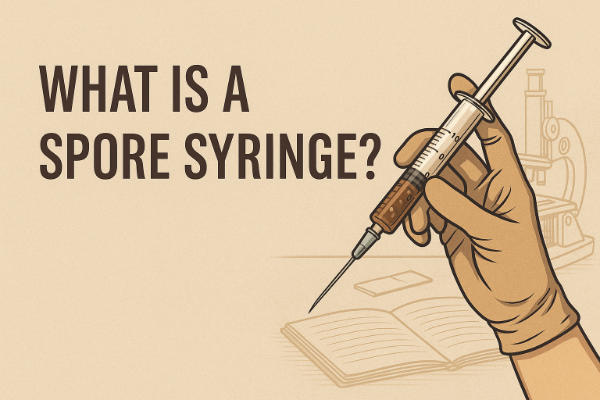
Whether you’re stepping into the world of mushroom microscopy for the first time or just stumbled across the term “spore syringe” while researching fungi, you might be wondering: what exactly is a spore syringe? In this in-depth guide, we’ll break it all down in simple, everyday language. You’ll learn what a spore syringe is, what it’s used for (especially in microscopy), how to use one properly, and even how to avoid common beginner mistakes. We’ll also link you to detailed guides throughout, so you can dive deeper into each topic. Let’s start at the beginning.
So, What Is a Spore Syringe?
A spore syringe is a sterile syringe filled with a mixture of water and mushroom spores—typically millions of them. These spores are microscopic reproductive cells produced by mushrooms, and when prepared properly, they can be suspended in a liquid solution and drawn into a syringe for study under a microscope. The syringe itself looks just like any medical syringe, but instead of medication, it contains a cloudy or speckled fluid. That cloudiness? It’s usually a sign of high spore density. Most spore syringes also come with a luer lock cap to keep them sealed and sterile until you’re ready to use them.
What Are Spore Syringes Used For
Spore syringes are primarily used for microscopy, taxonomy, and mycological research. Enthusiasts and amateur mycologists alike use them to study the microscopic characteristics of mushroom spores under a microscope.
If you’re brand new to microscopy, check out our beginner-friendly guide: How to Use Spore Syringes for Microscopy
Because of their legal status in many regions, spore syringes containing species like Psilocybe cubensis are often sold for microscopy and educational use only.
Important: In some places, possessing or using spore syringes with intent to cultivate psychoactive mushrooms is illegal. For a full legal breakdown, check out: Are Spore Syringes Legal?
How to Use a Spore Syringe for Microscopy
Using a spore syringe for microscopy is pretty straightforward, but sterility and technique are important. Here are the basic steps:
- Set up your clean workspace
- Attach the sterile needle (carefully)
- Expel a drop of spore solution onto a microscope slide
- Cover with a cover slip
- Examine under a microscope starting at low magnification
For a full walkthrough with tips and troubleshooting, don’t miss our full tutorial: How to Use Spore Syringes for Microscopy.
Common Beginner Mistakes (and How to Avoid Them)
Learning how to use a spore syringe properly is key to getting reliable results. Many beginners make the same handful of mistakes:
- Touching the needle or slide with bare hands
- Forgetting to shake the syringe before use
- Using too much liquid on a single slide
- Storing the syringe improperly
We break these down in detail here: Top 5 Mistakes Beginners Make with Spore Syringes.
Can You Tell If a Spore Syringe Is Contaminated?
Yes – sometimes. A contaminated spore syringe might contain:
- Fluffy white growth (indicative of mycelium or mold)
- Unusual discoloration (green, black, or pink)
- Foul odors when opened
While spore syringes are generally clean when purchased from reputable vendors, contamination can occur if they’re mishandled or stored improperly. Here’s how to recognize and deal with contamination: How to Tell If a Spore Syringe Is Contaminated.
How to Store a Spore Syringe
To preserve the viability of your spores:
- Keep the syringe in a cool, dark place
- Avoid exposure to sunlight or temperature extremes
- Store them in a sealed bag or container in the fridge (but not the freezer)
Proper storage can extend the life of your spore syringe for months or even years. Learn more here: How to Store Spore Syringes.
Can You Make a Spore Syringe at Home?
Yes! If you have a clean workspace and a spore print, you can create your own spore syringe. This is a great DIY project for intermediate hobbyists who want more control over their microscopy specimens.
You’ll need:
- A clean spore print
- Sterile distilled water
- A sterile syringe and needle
- A sterile shot glass or jar
Here’s our full guide with safety tips and photos: How to Make a Spore Syringe
What Strains Are Best for Beginners?
If you’re new to spore syringes, choosing the right strain can make a big difference in your experience. Some strains are more visually distinct or easier to handle under a microscope.
We’re covering this in depth in our upcoming guide: The Best Spore Syringe Strains for Beginners – Be sure to check it out if you want help choosing your first spores!
Next Steps
Check out our full range of spore syringes and educational resources. Whether you’re just starting out or looking to expand your collection, we’ve got you covered.
Happy Mushrooming!